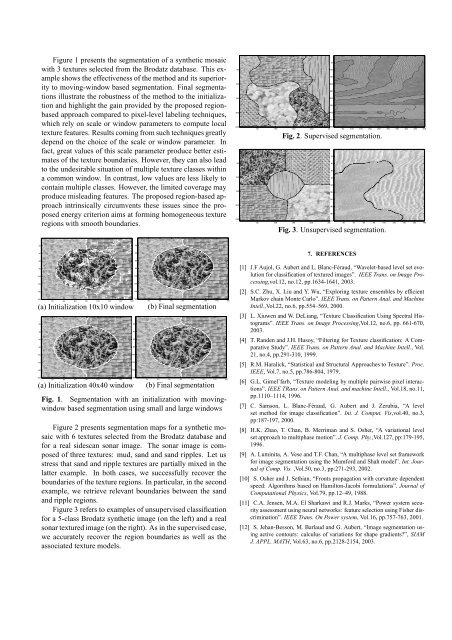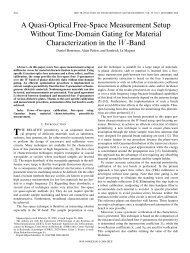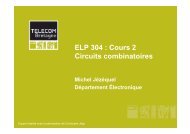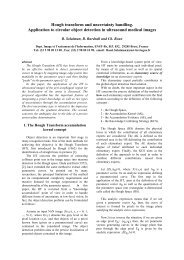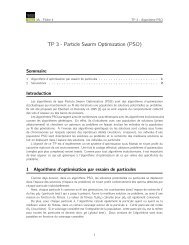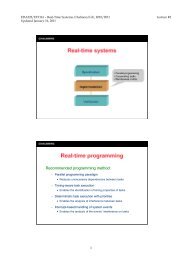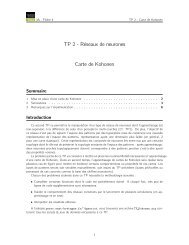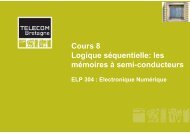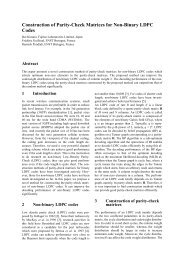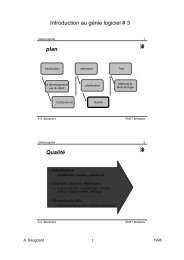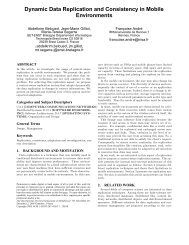REGION-BASED IMAGE SEGMENTATION USING TEXTURE ...
REGION-BASED IMAGE SEGMENTATION USING TEXTURE ...
REGION-BASED IMAGE SEGMENTATION USING TEXTURE ...
You also want an ePaper? Increase the reach of your titles
YUMPU automatically turns print PDFs into web optimized ePapers that Google loves.
Figure 1 presents the segmentation of a synthetic mosaicwith 3 textures selected from the Brodatz database. This exampleshows the effectiveness of the method and its superiorityto moving-window based segmentation. Final segmentationsillustrate the robustness of the method to the initializationand highlight the gain provided by the proposed regionbasedapproach compared to pixel-level labeling techniques,which rely on scale or window parameters to compute localtexture features. Results coming from such techniques greatlydepend on the choice of the scale or window parameter. Infact, great values of this scale parameter produce better estimatesof the texture boundaries. However, they can also leadto the undesirable situation of multiple texture classes withina common window. In contrast, low values are less likely tocontain multiple classes. However, the limited coverage mayproduce misleading features. The proposed region-based approachintrinsically circumvents these issues since the proposedenergy criterion aims at forming homogeneous textureregions with smooth boundaries.50100150200250501001502002505010015020025030035040045050050 100 150 200 250 50 100 150 200 250 300 350 400 450 500Fig. 2. Supervised segmentation.2040608010012014016018020050 100 150 200 25020 40 60 80 100 120 140 160 180Fig. 3. Unsupervised segmentation.204020407. REFERENCES608010012014016016020 40 60 80 100 120 140 160(a) Initialization 10x10 window2040608010012014016016020 40 60 80 100 120 140 160(a) Initialization 40x40 window60801001201402040608010012014020 40 60 80 100 120 140 160(b) Final segmentation20 40 60 80 100 120 140 160(b) Final segmentationFig. 1. Segmentation with an initialization with movingwindowbased segmentation using small and large windowsFigure 2 presents segmentation maps for a synthetic mosaicwith 6 textures selected from the Brodatz database andfor a real sidescan sonar image. The sonar image is composedof three textures: mud, sand and sand ripples. Let usstress that sand and ripple textures are partially mixed in thelatter example. In both cases, we successfully recover theboundaries of the texture regions. In particular, in the secondexample, we retrieve relevant boundaries between the sandand ripple regions.Figure 3 refers to examples of unsupervised classificationfor a 5-class Brodatz synthetic image (on the left) and a realsonar textured image (on the right). As in the supervised case,we accurately recover the region boundaries as well as theassociated texture models.[1] J.F Aujol, G. Aubert and L. Blanc-Féraud, “Wavelet-based level set evolutionfor classification of textured images”. IEEE Trans. on Image Processing,vol.12,no.12, pp.1634-1641, 2003.[2] S.C. Zhu, X. Liu and Y. Wu, “Exploring texture ensembles by efficientMarkov chain Monte Carlo”. IEEE Trans. on Pattern Anal. and MachineIntell.,Vol.22, no.6, pp.554–569, 2000.[3] L. Xiuwen and W. DeLiang, “Texture Classification Using Spectral Histograms”.IEEE Trans. on Image Processing,Vol.12, no.6, pp. 661-670,2003.[4] T. Randen and J.H. Husoy, “Filtering for Texture classification: A ComparativeStudy”. IEEE Trans. on Pattern Anal. and Machine Intell., Vol.21, no.4, pp.291-310, 1999.[5] R.M. Haralick, “Statistical and Structural Approaches to Texture”. Proc.IEEE, Vol.7, no.5, pp.786-804, 1979.[6] G.L. Gimel’farb, “Texture modeling by multiple pairwise pixel interactions”.IEEE TRans. on Pattern Anal. and machine Intell., Vol.18, no.11,pp.1110–1114, 1996.[7] C. Samson, L. Blanc-Féraud, G. Aubert and J. Zerubia, “A levelset method for image classification”. Int. J. Comput. Vis,vol.40, no.3,pp:187-197, 2000.[8] H.K. Zhao, T. Chan, B. Merriman and S. Osher, “A variational levelset approach to multiphase motion”. J. Comp. Phy.,Vol.127, pp:179-195,1996.[9] A. Luminita, A. Vese and T.F. Chan, “A multiphase level set frameworkfor image segmentation using the Mumford and Shah model”. Int. Journalof Comp. Vis. ,Vol.50, no.3, pp:271-293, 2002.[10] S. Osher and J. Sethian, “Fronts propagation with curvature dependentspeed: Algorithms based on Hamilton-Jacobi formulations”. Journal ofComputational Physics, Vol.79, pp.12–49, 1988.[11] C.A. Jensen, M.A. El Sharkawi and R.J. Marks, “Power system securityassessment using neural networks: feature selection using Fisher discrimination”.IEEE Trans. On Power system, Vol.16, pp.757-763, 2001.[12] S. Jehan-Besson, M. Barlaud and G. Aubert, “Image segmentation usingactive contours: calculus of variations for shape gradients?”, SIAMJ. APPL. MATH, Vol.63, no.6, pp.2128-2154, 2003.


